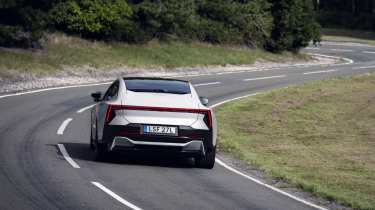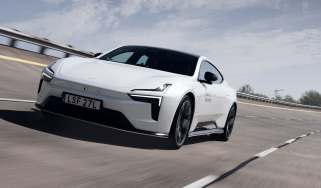New Polestar 5 prototype review: possibly the brand's best car yet
The Polestar 5 has almost certainly been worth the wait, it’s a stylish and engaging high-end EV like few others
Verdict
The Polestar 5 introduces a brand new and entirely bespoke chassis, yet despite the brand being part of a massive global conglomerate the tech has been developed by a small skunkworks team based right here in the UK. Polestar hasn’t just built a brilliant high-end EV, but has instilled it with a character, dynamic quality and a level of desirability that could be unmatched in the class. We’ll know for sure when we drive a mass-production version on the road, but this feels like a home-run for a brand that needs one.
Polestar is getting serious. Its push to become a high-tech premium brand has largely been driven by technologies and chassis architectures outside of its control, up to this point. The new Polestar 5 is different.
Different because unlike its range-mates, this Porsche Taycan-rivalling four-door GT has been designed from the ground up by a crack team of Polestar engineers based right here in the UK. The aim was to create a new standard in high performance four-seat EVs. Has all the effort and expense been worth it?
Our first taste of the new Polestar 5 is in the form of a late prototype, within the confines of the challenging Millbrook testing facility in the UK. Accurate and responsive are the first two words that come to mind. But this is no surprise as Polestar’s engineers have been at pains to tell us that they kept the car’s chassis and drivetrain refreshingly free of technology that can often disguise as much as augment a car’s fundamental dynamics.
The throttle is clean and super responsive – not unlike you’ll find on a Porsche Taycan – but perhaps even more impressive are the brakes which have immense stopping power combined with a consistent and reliable pedal feel. This is something that’s not always a given with EVs as the brake pedal needs to combine friction and regenerative braking.
Used - available now

2024 Honda
HR-V Hybrid
47,858 milesAutomaticPetrol1.5L
Cash £17,300
2022 Vauxhall
Crossland
8,583 milesAutomaticPetrol1.2L
Cash £13,965
2021 Ford
Focus
25,196 milesManualPetrol1.0L
Cash £13,000
2022 Citroen
C3 Origin
7,677 milesManualPetrol1.2L
Cash £11,500Polestar will offer two powertrain options, but we’re only driving the top-spec Performance model which will retail at £104,900 in the UK. This is a big number, but then its dual-motors produce a peak of 871bhp, which matches the more powerful and £30,000 more expensive Taycan Turbo.
However, the Polestar isn’t quite able to reach the incredible acceleration figures possible in a Porsche Taycan Turbo, and this is for a couple of reasons. First, the 5 is around 250kg heavier than the Porsche. Second, with its two-speed transmission, the Porsche is literally geared for hypercar levels of acceleration – the Polestar makes do with just a single-speed transmission.
In day-to-day life this is largely meaningless, however, as the Polestar’s overall performance is still immense. It doesn’t feel out-of-kilter with the chassis, though. Some high-powered EVs feel a little uncouth and out of control, but that’s not the case here. Thanks to the accurate throttle, you can feed the power in with complete confidence and the chassis just absorbs the incredible forces at work.
The torque split is somewhere around 30:70 front-to-rear, which gives the Polestar 5 a general rear-bias under hard acceleration, but retains excellent traction. The rear motor itself has been designed and is built in-house, and doesn’t feature any form of clever torque vectoring or a limited-slip differential – Polestar’s engineers say it just doesn’t need it.
At normal speeds, the ride quality is firm but superbly controlled, and despite the big wheels doesn’t feel brittle or crashy when hitting harsh road surfaces or potholes. The steering is also excellent, with great accuracy and a satisfying weight. When driving around the alpine route of Millbrook’s test facility, the Polestar 5 feels planted and controlled, and easily capable of handling its 2.5-ton kerb weight.
But the magic begins when you switch up the dampers and powertrain to their sportier modes. Unlike a rival Porsche Taycan with its active suspension systems, you can feel the weight of the car ebb and flow between the axles, creating a more engaging and controlled driving feel.
Official range figures have also been released. The Performance variant on 21-inch high performance rubber will achieve 351 miles. This is around 50 miles off the equivalent Porsche Taycan but the basic dual-motor Polestar 5 is capable of up to 416 miles, around 15 more than any Porsche Taycan. So if you’re after ultimate efficiency this might be the model to go for.
It’s also worth mentioning the driving position, general interior ambiance and cabin space. Polestar has done an incredible job of packaging the interior to be so spacious, especially in the rear. This is doubly impressive when you consider the car does without any form of rear window; the Polestar’s vast glass roof more than makes up for it. The luggage spaces, both front and rear, are useful, but in terms of pure literage, are slightly smaller than a Taycan.
Polestar’s digital interfaces are clean, easy to navigate. However, at this price we would understand if some customers would expect a little more in our new world of 1m-wide screens from Mercedes or the clever full-width digital cockpit inside the latest BMWs. The fundamentals are sound, though, and just add to the Poelstar’s more serene interior design ethos.
How does the Polestar 5 measure-up as a sports saloon? Sure, it lacks some of the theatrics of a petrol-engined alternative like an RS 7, but there’s a clarity to this car’s engineering which makes it very satisfying to drive. As an EV, this feels like a giant step forward, in the same way Porsche’s Taycan changed the game when it arrived back in 2019. We’ll have to wait until later in the year for our official verdict, but on our first impressions the new 5 will raise Polestar above just being another new-age EV brand. It is now a force to be reckoned with.
Want the latest car news in your inbox? Sign up to the free Auto Express email newsletter...









